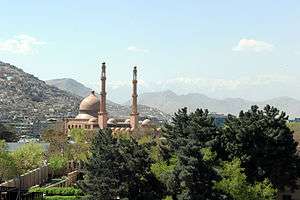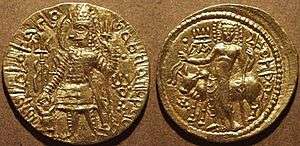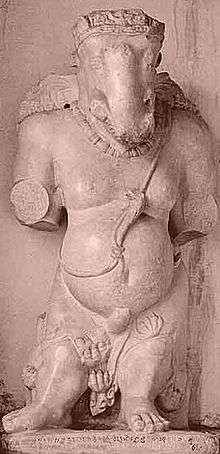Hinduism in Afghanistan
| Part of a series of articles on |
| Religion in Afghanistan |
|---|
 |
| Majority |
| Sunni Islam |
| Minority |
| Controversy |

Hinduism in Afghanistan is practiced by a tiny minority of Afghans, believed to be about 1,000 individuals who live mostly in Kabul and other major cities of the country.[1][2][3][4]
Before the Islamic conquest of Afghanistan, the Afghan people were multi-religious. The majority were followers of Hinduism and Buddhism.[5] Most Hindu temples were destroyed or converted into mosques by the 11th century.
History

There is no reliable information on when Hinduism began in Afghanistan but historians suggest that the territory south of the Hindu Kush was culturally connected with the Indus Valley Civilization in ancient times. At the same time, most historians maintain that Afghanistan was inhabited by ancient Arians tribes followed by the Achaemenid before the arrival of Alexander the Great and his Greek army in 330 BC. It became part of the Seleucid Empire after the departure of Alexander three years later. In 305 BCE, the Greeks gave up control of the territory south of the Hindu Kush to the Indian Maurya Empire as part of an alliance treaty.
Alexander took these away from the Aryans and established settlements of his own, but Seleucus Nicator gave them to Sandrocottus (Chandragupta), upon terms of intermarriage and of receiving in exchange 500 elephants.[6]— Strabo, 64 BC – 24 AD
When Chinese travelers, Faxian, Song Yun and Xuanzang explored Afghanistan between the 5th and 7th centuries AD, they wrote numerous travelogues in which reliable information on Afghanistan was stored. They stated that Buddhism was practiced in different parts between the Amu Darya (Oxus River) in the north and the Indus River.[7] However, they did not mention much about Hinduism although Song Yun did state that the Hephthalite rulers did not recognize Buddhism but "preached pseudo gods and killed animals for their meat".[7] The Chinese monks were followers of Buddhism, it is possible that they had no interest in writing about other religions. In addition, traveling in the Afghanistan region was too risky due to warlords and bandits.[7]
Kabul Shahi and Zunbil dynasty
Before the Islamic conquest of Afghanistan, the territory was a religious sediment of Zoroastrianism (northeast), Paganism (south and east), Buddhism (southeast), Hinduism (Kabul/Logar) and others. It was inhabited by various peoples, including Persians, Khalaj, Turks, and Afghans. South of the Hindu Kush was ruled by the Zunbils, offspring of the southern-Hephthalite. The east was controlled by the Kabul Shahis. The Zunbil and Kabul Shahis were connected by culture with the rest of the Indian subcontinent. The Zunbil kings worshipped a sun god by the name of Zun from which they derived their name. Some contemporary historians wrongly assume that everyone who worshipped idols in South Asia were Hindus. For example, André Wink writes that "the cult of Zun was primarily Hindu, not Buddhist or Zoroastrian."[9] Not all idol worship is considered part of Hinduism. Idol worship existed all over the world, including in Mecca, Saudi Arabia.[9]
In 653-4 AD, Abdur Rahman bin Samara along with 6,000 Arab Muslims penetrated the Zunbil territory and made their way to the shrine of Zun in Zamindawar, which was believed to be located about three miles south of Musa Qala in today's Helmand Province of Afghanistan. The General of the Arab army "broke of a hand of the idol and plucked out the rubies which were its eyes in order to persuade the Marzbān of Sīstān of the god's worthlessness."[10]
The Kabul Shahi ruled north of the Zunbil territory, which included Kabulistan and Gandahara. The Arabs reached Kabul with the message of Islam but were not able to rule for long. The Kabul Shahis decided to build a giant wall around the city to prevent more Arab invasions, this wall is still visible today.[11]
Willem Vogelsang in his 2002 book writes: "During the eighth and ninth centuries AD the eastern parts of modern Afghanistan were still in the hands of non-Muslim rulers. The Muslims tended to regard them as Indians, although many of the local rulers were apparently of Hunnic or Turkic descent. Yet, the Muslims were right in so far as the non Muslim population of Eastern Afghanistan was, culturally, strongly linked to the Indian sub-continent. Most of them were either Hindus or Buddhists."[12] In 870 AD the Saffarids from Zaranj conquered most of Afghanistan, establishing Muslim governors throughout the land. It is reported that Muslims and non-Muslims still lived side by side before the arrival of the Ghaznavids in the 10th century.
"Kábul has a castle celebrated for its strength, accessible only by one road. In it there are Musulmáns, and it has a town, in which are infidels from Hind."[13]— Istahkrí, 921 AD
The first confirmed mention of a Hindu in Afghanistan appears in the 982 AD Ḥudūd al-ʿĀlam, where it speaks of a king in "Ninhar" (Nangarhar), who shows a public display of conversion to Islam, even though he had over 30 wives, which are described as "Muslim, Afghan, and Hindu" wives.[14] These names were often used as geographical terms. For example, Hindu (or Hindustani) has been historically used as a geographical term to describe someone who was native from the region known as Hindustan (Indian subcontinent), and Afghan as someone who was native from a region called Afghanistan.[15]
Martin Ewans in his 2002 book writes: "Even then a Hindu dynasty the Hindu Shahis, held Gandhara and the eastern borders. From the tenth century onwards as Persian language and culture continued to spread into Afghanistan, the focus of power shifted to Ghazni, where a Turkish dynasty, who started by ruling the town for the Samanid dynasty of Bokhara, proceeded to create an empire in their own right. The greatest of the Ghaznavids was Mahmud who ruled between 998 and 1030. He expelled the Hindus from Ghandhara, made no fewer than 17 raids into India. He encouraged mass conversions to Islam, in Pakistan as well as in Afghanistan."[16]
When Sultan Mahmud of Ghazni began crossing the Indus River into Hindustan (land of Hindus) in the 10th century, the Ghaznavid Muslims began bringing Hindu slaves to what is now Afghanistan. Al-Idirisi testifies that until as late as the 12th century, a contract of investiture for every Shahi king was performed at Kabul and that here he was obliged to agree to certain ancient conditions which completed the contract.[17] The Ghaznavid military incursions assured the domination of Sunni Islam in what is now Afghanistan and Pakistan. Various historical sources such as Martin Ewans, E.J. Brill and Farishta have recorded the introduction of Islam to Kabul and other parts of Afghanistan to the conquests of and Mahmud:
The Arabs advanced through Sistan and conquered Sindh early in the eighth century. Elsewhere however their incursions were no more than temporary, and it was not until the rise of the Saffarid dynasty in the ninth century that the frontiers of Islam effectively reached Ghazni and Kabul. Even then a Hindu dynasty the Hindushahis, held Gandhara and eastern borders. From the tenth century onwards as Persian language and culture continued to spread into Afghanistan, the focus of power shifted to Ghazni, where a Turkish dynasty, who started by ruling the town for the Samanid dynasty of Bokhara, proceeded to create an empire in their own right. The greatest of the Ghaznavids was Muhmad who ruled between 998 and 1030. He expelled the Hindus from Gandhara, made no fewer than 17 raids into northwestern India,[18]
He encouraged mass conversions to Islam, in India as well as in Afghanistan.[18]
The Ghaznavid Empire was further expanded by the Ghurids. During the Khilji dynasty, there was also free movement between people from India and Afghanistan. It continued this way until the Mughals followed by the Suris and the Durranis. Hinduism has never been very popular in Afghanistan.
Modern period
The main ethnic groups in Afghanistan which practice Hinduism today are the Punjabis and Sindhis who are believed to have come along with Sikhs as merchants to Afghanistan in the 19th century.[19] Before the Soviet war in Afghanistan, there were several thousand Hindus living in the country but today their number is only about 1,000.[1] Most of the others immigrated to India, the European Union, North America or elsewhere.
Afghan Hindus and Afghan Sikhs often share places of worship. The main ethnic groups in Afghanistan which practice Hinduism are the Punjabis, and Sindhis who came as merchants to the region in the 19th century.[19] They once dominated the Afghan economy. Along with the Sikhs, they are all collectively known by some as Hindki.[20] Linguistic demographics among the Hindu community are diverse and generally follow regional origins: those hailing from Punjab generally speak Punjabi, Sindhis speak Sindhi, Kabulis and Kandharis speak both Pashto and the northern and southern dialects of Hindko. The local Hindu community in Afghanistan is mostly based in the city of Kabul. The 2002 loya jirga had two seats reserved for Hindus[21] and former President Hamid Karzai's economic advisor was an Afghan Hindu.
During the Taliban 1996 to late 2001 rule, Hindus were forced to wear yellow badges in public to identify themselves as non-Muslims so they would not be punished for not going to mosques during prayer times. Hindu women were forced to wear burqas, ostensibly a measure to "protect" them from harassment. This was part of the Taliban's plan to segregate "un-Islamic" and "idolatrous" communities from Islamic ones.[22]
The decree was condemned by the Indian and U.S. governments as a violation of religious freedom. Widespread protests against the Taliban regime broke out in Bhopal, India. In the United States, Abraham Foxman, chairman of the Anti-Defamation League, compared the decree to the practices of Nazi Germany, where Jews were required to wear labels identifying them as such.[23] Several influential lawmakers in the United States wore yellow badges with the inscription "I am a Hindu", on the floor of the Senate during the debate as a demonstration of their solidarity with the Hindu minority in Afghanistan.[24][25][26][27]
Indian analyst Rahul Banerjee said that this was not the first time that Hindus were singled out for state-sponsored oppression in Afghanistan. Violence against Hindus has caused a rapid depletion in the Hindu population over the years.[28] Since the 1990s, many Afghan Hindus have fled the country, seeking asylum in countries such as India, Germany and United States.[29]
In July 2013, the Afghan parliament refused to reserve seats for the minority group as a bill reserving seats for the mentioned was voted against. The bill by the then president Hamid Karzai, had tribal people and "women" as "vulnerable groups" who got reservation, but not religious minorities as per the religious equality article in the constitution.[30]
Ancient Hindu temples
| Place | Description | Other information |
|---|---|---|
| Sakawand Temple [31] | Logar Province [31] | |
| Polusha [32] | Bhima Devi (Durga) and temple of Maheshvera [32] | Visited by Xuanzang[32] |
|
Part of a series on
 |
See also
- Hinduism by country
- Religion in Afghanistan
- Sikhism in Afghanistan
- Buddhism in Afghanistan
- Pre-Islamic Hindu and Buddhist heritage of Afghanistan
- Khatri
- Punjabis in Afghanistan
- Hindkowan
References
- 1 2 Sikhs struggle for recognition in the Islamic republic, by Tony Cross. November 14, 2009.
- ↑ Minority Hindu and Sikh population shrinking in Afghanistan:US
- ↑ Legal traditions of the world: sustainable diversity in law, H. Patrick Glenn Edition 3, Oxford University Press, 2007
- ↑ "Dark days continue for Sikhs and Hindus in Afghanistan". Hindustan Times. Retrieved 12 May 2015.
- ↑ Al-Hind, the Making of the Indo-Islamic World: Early medieval India and the expansion of Islam, 7th-11th centuries, Volume 1 of Al-Hind, the Making of the Indo-Islamic World, André Wink, ISBN 90-04-09509-8, Publisher BRILL, 1990.
- ↑ Nancy Hatch Dupree / Aḥmad ʻAlī Kuhzād (1972). "An Historical Guide to Kabul – The Name". American International School of Kabul. Archived from the original on 30 August 2010. Retrieved September 18, 2010.
- 1 2 3 "Chinese Travelers in Afghanistan". Abdul Hai Habibi. alamahabibi.com. 1969. Retrieved August 9, 2012.
- ↑ For photograph of statue and details of inscription, see: Dhavalikar, M. K., "Gaņeśa: Myth and Reality", in: Brown 1991, pp. 50,63.
- 1 2 André Wink, "Al-Hind: The Making of the Indo-Islamic World", Brill 1990. p 118
- ↑ André Wink, "Al-Hind: The Making of the Indo-Islamic World", Brill 1990. p 120
- ↑ "The Kabul Times Annual". Kabul Times Pub. Agency, Information, Culture Ministry., 1970. p. 220.
- ↑ by Willem Vogelsang, Edition: illustrated Published by Wiley-Blackwell, 2002 Page 188
- ↑ "A.—The Hindu Kings of Kábul (p.3)". Sir H. M. Elliot. London: Packard Humanities Institute. 1867–1877. Retrieved September 18, 2010.
- ↑ Vogelsang, Willem (2002). The Afghans. Wiley-Blackwell. p. 18. ISBN 0-631-19841-5. Retrieved 2012-08-16.
- ↑ David Lorenzen. Who Invented Hinduism: Essays on Religion in History. Yoda Press. p. 9. ISBN 9788190227261.
- ↑ Afghanistan: a new history By Martin Ewans Edition: 2, illustrated Published by Routledge, 2002 Page 15 ISBN 0-415-29826-1, ISBN 978-0-415-29826-1
- ↑ Al-Idrisi, p. 67, Maqbul Ahmed; Al-Hind, the Making of the Indo-Islamic World, 1991, p. 127, Andre Wink.
- 1 2 Afghanistan: a new history by Martin Ewans Edition: 2, illustrated Published by Routledge, 2002 Page 15 ISBN 0-415-29826-1, ISBN 978-0-415-29826-1
- 1 2 Majumder, Sanjoy (2003-09-25). "Sikhs struggle in Afghanistan". BBC. Retrieved 2009-12-17.
- ↑ "Hindki". Encyclopædia Britannica Eleventh Edition. Retrieved 2007-09-15.
- ↑ Afghanistan's loya jirga BBC 0- June 7, 2002
- ↑ Taliban to mark Afghan Hindus,CNN
- ↑ Taliban: Hindus Must Wear Identity Labels,People's Daily
- ↑ WorldWide Religious News - U.S. House condemns Taliban over Hindu badges; Reuters, June 13, 2001
- ↑ CNSNEWS - US Lawmakers Condemn Taliban Treatment Of Hindus
- ↑ US Lawmakers say: We are Hindus, Rediff News
- ↑ Afghanistan News Center
- ↑ US Lawmakers Condemn Taliban Treatment Of Hindus,CNSnews.com
- ↑ Immigrant Hinduism in Germany: Tamils from Sri Lanka and Their Temples,pluralism.org
- ↑ "We condemn the discrimination against Sikhs and Hindus of Afghanistan". Kabul Press. Retrieved 12 May 2015.
- 1 2 Buddhist caves of Jāghūrī and Qarabāgh-e Ghaznī, Afghanistan By Giovanni Verardi, Elio Paparatti Page 102
- 1 2 3 A History of civisalition of Ancient India Vol 11, by Romesh Chander Dutt, p. 135
External links
- www.afghanhindu.info
- The Afghan Hindu Association of America
- Hindus abandon Afghanistan, Hinduism Today, 2 April 1994
- Inscription throws new light to Hindu rule in Afghanistan, Indian Express 5 January 2010
